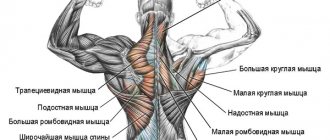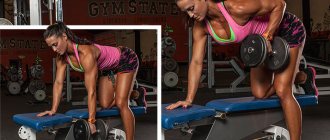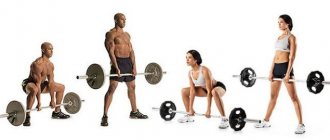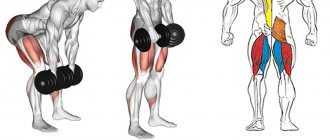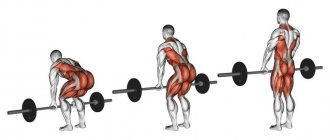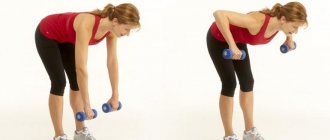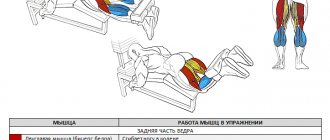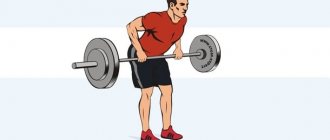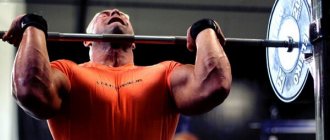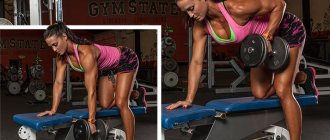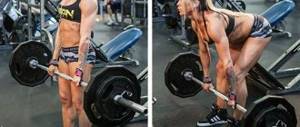Pulling weights (barbells or dumbbells) from the floor can be different. The most popular are the deadlift, Romanian, as one of the varieties of the deadlift, straight leg deadlift and a number of other modifications of this exercise. The deadlift differs in its execution technique and is suitable for beginners, as well as girls, in contrast to the same classic deadlift.
What you need for deadlift exercises
Correct positioning of the body and legs requires a good stretch of the lower back. When the muscles and ligaments are weakly stretched, an error often occurs when performing the exercise - rounding, arching of the lower back, which can lead to injury. In addition, the backs of your legs must be stretched to perform a stiff-legged deadlift. If the stretch has not yet reached the desired level, you will not be able to lower the weight or lift it correctly.
Do not perform this exercise if you have back pain.
Errors during execution
Due to the similarity with other deadlift variations, performing a deadlift is accompanied by a number of common mistakes:
- Legs bend at the knees. This shouldn't happen. The movement is carried out exclusively by the body - try to stretch as much as possible so that your back does not round.
- The head tilts or falls. The gaze should always be directed only forward.
- Working with excessive weight is accompanied by rounding of the back. This can lead to spinal problems and back injuries.
- Insufficient warming up of muscles and ligaments before this exercise cost many athletes their health.
- Violation of execution technique. If your back and arms get tired faster than the backs of your legs, you're doing something wrong.
How the muscles work in this exercise
Both deadlifts and deadlifts use several muscle groups at once. The heaviest load is placed on the back muscles and the back of the thighs. When performing a deadlift, the quadriceps is not pumped, which distinguishes it from a deadlift. The fact is that the legs should remain straight, so there should be no work of these muscles.
The following muscles will be involved:
- back extensor group;
- gluteus maximus muscle;
- semitendinosus muscle;
- semimembranosus muscle;
- biceps femoris muscle.
Exactly which muscles work when performing a deadlift explains why the exercise is especially loved by women. Pumping up your back helps you maintain ideal posture, and working your hip muscles promises to give aesthetics to your buttocks and thighs. An additional part of the load goes to the upper back muscles, inner thighs, forearms, and abdominal muscles.
Deadlift exercise for women with dumbbells
The exercise is a variation of the deadlift that is so popular that it has long been distinguished as a separate exercise. This exercise doesn't involve chasing weights like its companion exercise, but in terms of working on your figure rather than lifting weights, it beats it significantly.
The exercise specifically allows us to work on the gluteal muscles and the muscles of the posterior thigh (well, and many other back extensor muscles, deltas and others that are not of interest to us at the moment)
.
A distinctive feature of the exercise (in relation to the classic deadlift)
is that it is performed on conditionally straight legs.
The exercise is often performed by men, working on the hamstrings, but today we will talk specifically about its implementation with an emphasis on the gluteal muscles. And to be even more precise, on the top of the buttocks, which are usually difficult to work on.
1. Starting position
We stand in front of the barbell, place our feet approximately shoulder-width apart in a comfortable, stable position. Bend your legs slightly at the knees to relieve the stress on the knee joints. We bend a little at the lower back and bring our shoulder blades together. We squat to a level that will allow us to reach the barbell and from the squat we smoothly get up with the barbell, maintaining a bend in the lower back (diving movement)
. This only applies to lifting the barbell from the floor.
And now a little about the emphasis on the top of the buttocks. The first thing you need to do is turn your feet slightly with your toes inward. This shifts the load up and out of the glutes. Accordingly, if you need to focus more attention on the inside of the buttocks, then turn your toes to the sides, but as a rule, there are no problems with this anyway.
The exercise can be performed with either a barbell or dumbbells. There is no fundamental difference, it is more convenient for someone. Try both options and choose the more suitable projectile for yourself.
2. Grip, grip width
You should choose the most comfortable grip width for yourself; technically, it does not affect the exercise in any way.
With grip options, the story is the same as in the deadlift, or bent-over barbell row, etc.
Straight grip (2 in the picture)
will be the most suitable option, but a different grip
(3 in the figure)
if it is more convenient for you, because it makes holding the bar easier. Straps can also help with this.
2 - straight grip; 3 - different grip.
3. Doing the exercise
So, now that we are prepared and in position, let's get started.
Take a barbell from the floor (or dumbbells)
, bent at the waist, the back is straight, the shoulder blades are brought together.
Socks together (optional, the main thing is that this does not affect stability).
As we inhale, we begin to smoothly lower, moving the pelvis back and maintaining a deflection in the lower back. At the same time, in order to again emphasize the load on the gluteal muscles, we try at the very beginning of the downward movement, as if to resist with the gluteal muscles the pulling of the pelvis back. Those. we don’t just move the pelvis back, but already at this stage we tense the muscles and the downward movement is controlled. Imagine that your back is moving your pelvis back and down, and your buttocks are trying to hold your pelvis in place. This point is quite difficult to understand, but after several trainings it will become possible. You will begin to feel the tension in your gluteal muscles not only when moving up, but also when moving down.
Unlike classic deadlifts, there is no need to lower yourself to the floor. Approximately to the level of the knees, or a little lower, as far as your flexibility allows. Make sure your muscles are constantly under load.
Deadlift technique
Before starting the exercise, be sure to do a good, complete warm-up. It should include stretching of the calves, lower back, and hamstrings. This will help avoid pain and reduce the chances of injury during exercise.
Procedure for performing deadlifts with a barbell:
- Stand in the starting position - your legs are narrower than your shoulders, the weight (barbell) is in your hands, your toes can be slightly turned outward.
- Shoulder blades together, neck straight, look forward. Bend your lower back slightly, move your pelvis slightly back.
- Straighten your knees. Hold the barbell at shoulder width, with a straight grip.
- Start of movement. The bar of the bar moves as straight down as possible, focusing on the middle of the foot.
- The back is straight, lower the bar only by moving the pelvis back and bending the lower back. You cannot bend your lower back outward or bend your knees.
- For the first time, you can stop lowering the weight at knee level. Improving the stretch later will allow you to lower the weight to the floor, but do not overstrain the ligaments from the first approach. Of course, the larger the diameter of the plates, the easier it will be to lower the bar to the floor.
- You need to lift the weight using the lower back muscles. As you lift the weight, gradually squeeze your shoulder blades together to return to the starting position. The main tension is on the lower back and back of the hips.
Important! Exhale as you lift, inhale as you lower the weight!
You need to understand that the deadlift will not allow you to lift the same weight as the deadlift, since the strong leg flexors that are used in the deadlift are practically not used in the deadlift. However, this exercise is more about increasing muscle endurance than pumping up their strength.
Deadlift technique
Despite the apparent similarity of the deadlift and deadlift, not to mention the Romanian, each of them is considered a separate exercise, since different muscle groups are involved. In addition, they also have different techniques from each other, in which it is sometimes quite difficult to notice the difference.
Deadlifts are performed using the following technique:
- Equip the barbell with the required weight and place it in front of you.
- Feet should be shoulder-width apart.
- Squat down and grab the barbell using an overhand grip (palms facing you).
- The grip should be such that your hands are slightly wider apart, shoulder width apart.
- Take the barbell and straighten up with it.
- Then, slowly lower your body forward so that the bar is below knee level.
- Then rise up and return to the starting position.
Execution nuances:
- Never round your back. The back should be straight from the beginning of the lifting of the bar to its lowering.
- The gaze should always be directed only forward - the head should not rise or fall.
- Use only an overhand grip, as other types of grip will put extra stress on your lower back.
- The knees should always remain straight - this gives the buttocks a great stretch as they lower.
- Try to keep the barbell as close to your body as possible at all times. Shoulders and chest should be straightened.
- Choose a stable position in which it will be convenient to lift the barbell without staggering or using inertia to perform it.
In many ways, the deadlift technique is similar to the Romanian one, but there are a number of important differences:
- The deadlift is performed with straight legs, while in the Romanian the knees are slightly bent. Due to straight legs, the area of the buttocks and thighs is greatly stretched.
- When lowering the barbell in the Romanian version, the first thing you need to do is move your body back. When performing a dead exercise, the lower part is fixed, only the body moves, lowering and rising.
- When performing deadlifts, your stretch level is important. If the Romanian allows for bending of the knees, and, as a result, a decrease in the amplitude of movement. In the case of a deadlift, you should lower the barbell exactly to the level where your back begins to round.
- When returning to the starting position, in the Romanian deadlift the pelvis moves forward - this puts a strong load on the buttocks area. There is no such movement in the dead; the pelvis does not move back.
Basic mistakes when doing exercises
Mistakes occur due to poor preparation, poor stretching and inattention when performing deadlifts. That is why the warm-up needs to be done as thoroughly as possible. During the exercise, you need to carefully listen to which muscles are tense in order to regulate the position of the body.
The most common mistakes:
- Bend your knees. On the one hand, you don’t need to straighten your knees all the way, but on the other hand, they need to be left in a straight position in order to perform deadlifts, and not variations on the Romanian theme. To straighten you need a good stretch. It is optimal to prepare for performing exercises on a hyperextension machine.
- Lowering the head. You have to look straight ahead. It is convenient to practice in front of a mirror, so mistakes will be obvious.
- Arching, rounding of the lower back. As soon as you let go of your lower back, your entire back begins to round. This may cause injury. The weight is lifted by the entire back, not just the lower back, so you need to pay attention to the position of the lower back.
- Incorrect shoulder position. Deadlifts cannot be combined with shrugs; the shoulders must be straightened from the starting position. Try to fix them at the beginning of the exercise and not move them, as this interferes with the pumping of the necessary muscles and can also cause injury.
Deadlift, exercise options
You can perform deadlifts with a barbell or two kettlebells, with a very stiff resistance band, or on a cable machine.
You can also experiment with the angle of your feet. The most powerful impact on the hamstrings occurs when the feet are turned toes inward. In this “clubfoot” pose, the hamstrings are stretched more strongly and are better felt.
You can also bend your knees slightly and hold them in this position during the approach. This will shift the emphasis of the exercise to the buttocks and will temporarily bypass the problem of insufficient flexibility.
Deadlift with a barbell Deadlift in a Smith machine
Tag dumbbell gymnastics deadlift power stretching pelvic dominance exercises
How can you replace deadlifts for a similar effect?
Other types of exercises can be used to pump the back of the thighs and work the lumbar muscles. If stretching does not allow you to do deadlifts, in the process of preparing the body, the following options are quite suitable as a replacement:
- Pulling your legs back with weights. One of the most popular fitness exercises that can be performed both without weights and with weights. Feet together, back straight, hands on waist. As you inhale, slowly move your leg back as far as it will go, and just as slowly return it to its original position. Carry out 10-15 repetitions, change legs. It is optimal to use plate weights, as they interfere less during the exercises.
- Reverse hyperextension. It is considered safer than direct hyperextension, since the risk of injury is minimal. Performing is permissible even in the presence of hernias. The exercise takes place in a lying position on a surface, the height of which allows you to lower your legs in a flat position to the floor. The body is fixed using hands. As you exhale, raise your legs as high as possible, as far as the stretch allows. Hold the raised position for a second, and while inhaling, lower your legs to the starting position.
- Leg extension in the simulator. The exercise is aimed at working the quadriceps; it bears the main load. Performed using a simulator, the starting position is sitting, legs bent at the knees. As you exhale, calmly straighten your legs under the bolsters. As you inhale, lower slowly, not allowing the muscles to completely relax. Perform repetitions in the same order.
- Leg press to work the back of the thigh. It is performed in a special simulator located at an angle of 45 degrees. The back and head are pressed tightly against the back. Feet as high on the platform as possible, spread as wide as possible for maximum benefit from the exercise. Hands on the handrails. After releasing the holders, begin to lift the platform by extending your legs. It is best performed in the presence of a trainer.
- Classic hyperextension. A basic exercise to work the muscles of the back, buttocks and thighs. Starting position on your stomach, arms on your chest, bend at the waist over the bench at an angle of 45 degrees. Place your legs behind the bolsters for fixation. As you exhale, raise your body and hold in this position. As you exhale, slowly lower the body to the starting position.
Having pumped up the muscles and improved stretching thanks to the above exercises, you can then move on to deadlifts. Well-stretched ligaments and muscles will allow you to start deadlifting. While the stretching is not good enough, you should not start deadlifting, this can lead to injuries and a long recovery. Have a productive workout!
What muscles work when performing the exercise?
Most of the work is done by:
- Lumbar - they lift and return the body to its original position.
- The muscles of the buttocks and biceps of the thigh - when performed, they stretch well, which allows them to be given an excellent load. Synergistically interacting with the lumbar region, they provide the push necessary to lift the body.
In addition to them, the following are used:
- Core muscles - help to hold the barbell without changing the position of the body.
- The muscles of the forearms, shoulders and trapezius are needed to hold and fix the barbell.
- The calf and ankle stabilizer muscles provide a stable position.
In fact, we could go on and on about which muscles work during a deadlift. Since it is a subtype of the classic deadlift, it includes the combined action of many muscle groups, large and small. By interacting and complementing each other’s work, they turn the deadlift into one movement that develops the entire body.

